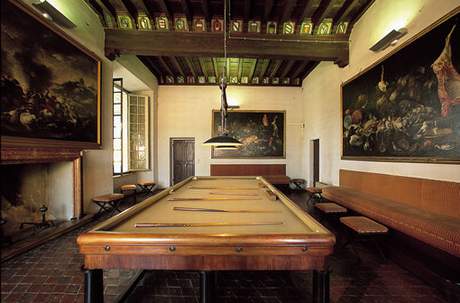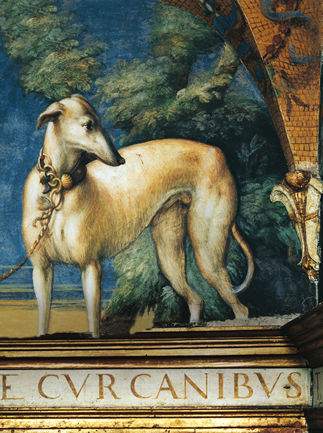|
The Story
Fontanellato was inhabited from the Bronze age onwards (1800 BC), as documented by Luigi Pigorini, citizen of Fontanellato, who in 1888 discovered a lake-dwelling settlement.
After 1000 AD, Fontanellato gradually began to develop, and from the primitive castle to its modern-day configuration it expanded without suffering any major upheavals. In fact during the twentieth century the town developed away from the original city, with the old centre protected by the outer city walls with a wide moat running around the perimeter.
Today, the main through roads of the town pass by this moat and the town's current configuration is based on its late-Medieval plan.
 The castle was founded in 1124 when the Pallavicino family built the first defence tower (the present-day square tower). In 1386, after various changes in ownership, the castle was handed over to the Sanvitale family from the Dukes of Milan, the Visconti, who invested the Sanvitale family as Counts of Fontanellato. The castle was founded in 1124 when the Pallavicino family built the first defence tower (the present-day square tower). In 1386, after various changes in ownership, the castle was handed over to the Sanvitale family from the Dukes of Milan, the Visconti, who invested the Sanvitale family as Counts of Fontanellato.
In the early 15th century, Count Gilberto II Sanvitale carried out work, which was completed in the 16th century, with the first floor being transformed into the piano nobile, and other parts being changed.
At the end of the 16th century, the Rocca was permanently changed from a military fortress into a residential seat and became one of the most enlightened minor courts in the Po Valley area during the Renaissance. The castle then became a civilian residence in the 18th century where the family continued to live.
The history of the town and the Rocca is linked to the Sanvitale family, who were the feudatories and remained in Fontanellato up until 1948 when the last Count, Giovanni, sold the Castle to the town and under him the Fontanellato branch of the family was extinguished.
The Castle, which the Sanvitale family wanted to be known as the “Fortress” (Rocca), is surrounded by a wide moat. The Castle has a square plan with four corner towers (three round towers and one square tower). Up until the late 18th century, a drawbridge led into the castle and this was replaced in the early 19th century by the brick bridge which stands today.
The 15th century stables opposite the castle and now privately owned, were once a part of the castle, along with the large park which extends to the banks that run around the town.
 Let's go into the Castle: on the piano nobile, the charm of the rooms has remained intact for more than five centuries. Our visit shall begin with the “Hall Arms” (Sala delle Armi), moving on to the “Dining Room” (Sala da Pranzo), with two, still life paintings by Felice Boselli (1686) and a collection of ceramics dating from the 16th, 17th and 18th centuries adorning it, the “Billiard Room” (Sala da Biliardo), with its 15th century terracotta floor and early 16th century beamed ceiling, to the “Reception Room” (Sala da Ricevimento” with a Baroque harpsichord (late 17th century), Louis XV and Louis XVI period gilt furniture and the “Bridal Room” (Camera Nuziale” with its impressive carved walnut panelled ceiling dating from 1620. Let's go into the Castle: on the piano nobile, the charm of the rooms has remained intact for more than five centuries. Our visit shall begin with the “Hall Arms” (Sala delle Armi), moving on to the “Dining Room” (Sala da Pranzo), with two, still life paintings by Felice Boselli (1686) and a collection of ceramics dating from the 16th, 17th and 18th centuries adorning it, the “Billiard Room” (Sala da Biliardo), with its 15th century terracotta floor and early 16th century beamed ceiling, to the “Reception Room” (Sala da Ricevimento” with a Baroque harpsichord (late 17th century), Louis XV and Louis XVI period gilt furniture and the “Bridal Room” (Camera Nuziale” with its impressive carved walnut panelled ceiling dating from 1620.
Lastly, there is the “Ancestors' Gallery” (Galleria degli Antenati), with portraits of the Sanvitale Family arranged on the walls in chronological order.
The tour continues in the roof garden on the ramparts of the southern side of the castle, where inside the corner tower is the “Optical Chamber” (Camera Ottica). Here an ingenious system of lenses reflections on two concave surfaces of views of the town's piazza and the parvis of the Church of Santa Croce, with their daily to-ings and fro-ings. On the ground floor is the Renaissance quarter, with the “Small Hall” (Camerino) (as it was called in first documents) of Diana and Actaeon, frescoed by Parmigianino and the “Art Gallery” (Pinacoteca) housing works dating from the 18 and 19 centuries relating to the history of the family, along with maps of the area which bear witness to the once thriving estate.
The "Camerino di Diana e Atteone", Parmigianino's masterpiece
The painter Francesco Mazzola, called il Parmigianino and genius of Mannerism, was born in Parma in 1503 and died at Casalmaggiore at the early age of 37. Fontanellato consecrated the genius of this young artist, with Count Galeazzo summoning Parmigianino in 1523, who was just 20 at the time, to fresco a room which dark and hidden away, yet of great importance for the culture and history of the family, and which has since become a mesterpiece in the history of Italian art.
The fresco takes its theme from the myth of Diana who transforms Actaeon into a stag after he has spied on her bathing naked. The tale develops as a sort of natural theatre, the ceiling frescoed with a green arbour and masks, revealing glimpses of sky, and an open sky with round mirror in the middle with the words “Respice finem” (Look to the end).
On three of the four walls, above the verses from Ovid's Metamorphosis which narrate the tale, the scenes are depicted. From the hunt in the woods, to the meeting with the Goddess who is bathing in the holy lake and who splashes Actaeon, up to the terrible scene of Actaeon as a stag who is savaged by his own dogs.
On the fourth wall a charming, female figure depicts Paola Gonzaga, wife of Count Galeazzo, who holds the symbols of life and sacrifice in her hands: ears of corn and a vessel for wine. Was the scene actually depicting the Countess bathing, dedicated to her with nuptial passion? Was is a study of the Count? Or a tribute to alchemy – a passion of Parmigianino – as perhaps the purifying elements of water and other natural elements suggest? Or perhaps the inscription to the goddess for the cruelty of her punishment is an invocation to the grave losses suffered by the family in those times? Experts have dedicated many pages to these uncertainties, which contribute to the delight and wonder of everyone who sees this magical room for themselves.
The young Parmigianino took the great work of Antonio Allegri, il Correggio, as his model, reinterpreting and personalisng the style.
His quest for grace and feminine beauty led him to create flawlessly elegant and formally perfect works, as can be seen in the human and animal forms, such as the greyhounds silhoutted against the natural backgrounds tinged with the hues of a sunset in the Po valley. Commenting on Parmigianino, Vasari notes (from as early a date as 1568) that “among many gifted with the delightful skill of drawing and...of a particular manner of painting...none come before, in fact all others come after Francesco Mazzuoli, from Parma...”
Getting to Fontanellato: A1 Motorway (Autostrada del Sole): from Bologna, exit at "Parma Ovest", from Milan exit at "Fidenza"; A15 Motorway (Autostrada della Cisa) exit at "Parma Ovest".
Texts and photo are published by kind permit of Tourist Office of Municipality of Parma
|



 Munch: The Scream Within
Munch: The Scream Within In the garden
In the garden Perugia Travel Guide
Perugia Travel Guide


 The castle was founded in 1124 when the Pallavicino family built the first defence tower (the present-day square tower). In 1386, after various changes in ownership, the castle was handed over to the Sanvitale family from the Dukes of Milan, the Visconti, who invested the Sanvitale family as Counts of Fontanellato.
The castle was founded in 1124 when the Pallavicino family built the first defence tower (the present-day square tower). In 1386, after various changes in ownership, the castle was handed over to the Sanvitale family from the Dukes of Milan, the Visconti, who invested the Sanvitale family as Counts of Fontanellato. Let's go into the Castle: on the piano nobile, the charm of the rooms has remained intact for more than five centuries. Our visit shall begin with the “Hall Arms” (Sala delle Armi), moving on to the “Dining Room” (Sala da Pranzo), with two, still life paintings by Felice Boselli (1686) and a collection of ceramics dating from the 16th, 17th and 18th centuries adorning it, the “Billiard Room” (Sala da Biliardo), with its 15th century terracotta floor and early 16th century beamed ceiling, to the “Reception Room” (Sala da Ricevimento” with a Baroque harpsichord (late 17th century), Louis XV and Louis XVI period gilt furniture and the “Bridal Room” (Camera Nuziale” with its impressive carved walnut panelled ceiling dating from 1620.
Let's go into the Castle: on the piano nobile, the charm of the rooms has remained intact for more than five centuries. Our visit shall begin with the “Hall Arms” (Sala delle Armi), moving on to the “Dining Room” (Sala da Pranzo), with two, still life paintings by Felice Boselli (1686) and a collection of ceramics dating from the 16th, 17th and 18th centuries adorning it, the “Billiard Room” (Sala da Biliardo), with its 15th century terracotta floor and early 16th century beamed ceiling, to the “Reception Room” (Sala da Ricevimento” with a Baroque harpsichord (late 17th century), Louis XV and Louis XVI period gilt furniture and the “Bridal Room” (Camera Nuziale” with its impressive carved walnut panelled ceiling dating from 1620.